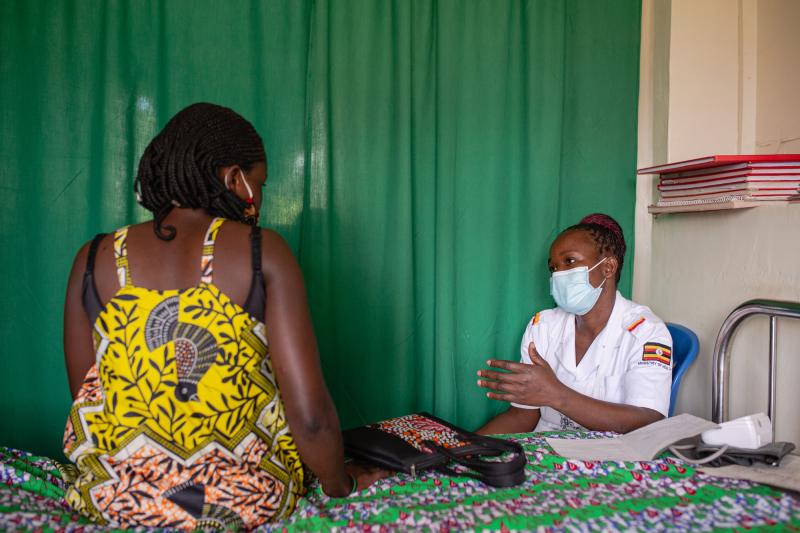Where We Work
See our interactive map


A client talks to a health worker at Nakaloke Health Center III in Mbale, Uganda. Photo by Esther Ruth Mbabazi for IntraHealth International.
How satisfied clients are helping new users access services.
In Uganda, the total fertility, maternal mortality, and teenage pregnancy rates remain among the highest in the world. UNICEF reports that 18 mothers die every day in pregnancy or during and after childbirth in the country.
That’s why Uganda is renewing its commitment to scale up the use of modern family planning methods and make sure every Ugandan woman can choose when and how many children to have.
As part of this commitment, the Government of Uganda and its partners are expanding family planning services and providing more long-acting, reversible, and permanent methods in the region to reduce the unmet need for family planning to 10% and increase the modern contraceptive prevalence rate to 50%. Increasing this rate is vital to preventing maternal and childhood morbidity and mortality.
Eastern Uganda, in particular, still struggles with a high unmet need for family planning. Rumors, misconceptions, fears about family planning services, and some cultural and religious beliefs prevent many people from using contraception. This is worsened because some health workers can’t provide family planning services for women of reproductive age at due to:
To address these challenges, the USAID-funded Regional Health Integration to Enhance Services in Eastern Uganda (RHITES-E) project provides continuous mentorships for health workers and free family planning services for clients, works with volunteer health teams, and engages youth champions.
But one of their most successful approaches in the region is the project’s partnership with satisfied clients who use their experiences with modern family planning methods to talk to other interested community members about using them as well.In health facilities and during door-to-door visits in their communities, they talk to young people about the benefits of delaying first pregnancies, spacing births, and smaller family sizes.
These types of referrals from satisfied family planning users have been vital in increasing family planning access and use in rural Uganda. In 2021, RHITES-E reached 853,044 family planning users and saw a 7.73% increase in new users compared to 2020. Family planning use among adolescents has also increased to 102,972 in 2021—a 2.2% increase from 2020 in the region.RHITES-E uses this referral approach to address the low uptake of family planning in the region, especially in districts struggling to increase family planning use. The Apapai Health Center III in the Serere District is one of eight health facilities implementing this approach—and it’s working. Of the 147 Clients who accessed family planning services there, 75 clients (51%) were referred by the satisfied family planning users.
This referral system has been particularly effective during the pandemic.
So how does this system work? First, the health facility management team working for RHITES-E identifies satisfied family planning users who are willing to share their experiences using modern family planning methods. Then we provide them with educational materials, training on family planning basics, and a small transport stipend for their door-to-door outreach.
“Talking to young women and girls about the benefits of family planning has been fulfilling,” says Joseph Ebou, one of the satisfied family planning users. “Many clients feel comfortable approaching us for more information after our health education talks and I’m able to refer them to the provider.”
The satisfied users are also deployed at different entry points in health facilities to talk to potential clients about family planning and bust myths and misconceptions. Then they refer new clients to the family planning clinic for further counseling with a skilled health worker.
“Key entry points—such as maternity wards and children’s immunization and growth monitoring clinics—were targeted to reach clients with family planning talks,” says Margaret Irumu, the focal person for family planning at Apapai Health Center IV. “Then, they go to provider-initiated family planning counseling.”
This referral system has been particularly effective during the pandemic when fewer people are coming to the health facilities. The satisfied users’ home visits reach underserved clients and help more women and girls maintain access to life-saving contraception.
RHITES-E will continue to prioritize similar interventions to decrease the unmet need and increase the use of family planning, particularly among adolescent clients and young women and their partners. And, RHITES-E will scale-up these best practices to improve family planning uptake in other regions.
Get the latest updates from the blog and eNews




